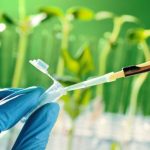A powerful catalyst for electrolysis of water that could help harness renewable energy

Nowadays, people acknowledge the importance of finding and improving renewable energy sources. One strategy to generate energy is breaking water molecules (H2O) apart in an electrochemical reaction known as electrolysis. This process allows us to convert energy from the sun or other renewable sources into chemical energy. However, electrochemically splitting water molecules requires an overpotential—an excess voltage that has to be applied in addition to the theoretical voltage (1.23 V vs reversible hydrogen electrode or RHE) so that the necessary reactions can occur.
Electrocatalysts are materials that, because of their electrical and morphological features, facilitate electrochemical processes. Researchers have been searching for electrocatalysts that can aid in the electrolysis of water, and some of the best catalysts are noble-metal oxides, which are rare and costly. Nickel-based hydroxide (Ni(OH)2) compounds are, fortunately, a better alternative.
A team of scientists, including Profs. Hyunsik Im and Hyungsang Kim from Dongguk University, intercalated polyoxovanadate (POV) nanoclusters into Ni(OH)2 arranged in ordered layers and found that doing this improves its conducting and morphological properties, which in turn enhances its catalytic activity. They employed a promising method called chemical solution growth (CSG), wherein a highly saturated solution is prepared, and the desired material structure naturally forms as the solutes precipitate in a predictable and controlled fashion, creating a layer-by-layer structure with POV nanoclusters intercalated between the Ni(OH)2 layers.
The team demonstrated that the resulting house-of-cards-like structure greatly reduced the overpotential needed for the electrolysis of water. They attributed this to the morphological features of this material; the POV nanoclusters increase the spacing between the Ni(OH)2 layers and induce the formation of micropores, which increases the surface area of the final material and the number of catalytic sites where water molecules can be split. “Our results demonstrate the advantages of the CSG method for optimizing the pore structure of the resulting material,” explains Prof. Im.
Facilitating the electrolysis of water using novel catalysts is a step toward achieving a greener future. What’s more, the CSG method could be useful in many other fields. “The facile CSG deposition of nanohybrid materials may be useful for applications such as the production of Li-ion batteries and biosensors,” states Prof. Kim. Only time will tell what new uses CSG will find.
Reference
|
Authors: |
Jayavant L. Gunjakar1,2, Bo Hou3, Akbar I. Inamdar1, Sambhaji M. Pawar1, Abu Talha Aqueel Ahmed1, Harish S. Chavan1, Jongmin Kim1, Sangeun Cho1, Seongwoo Lee1, Yongcheol Jo1, Seong-Ju Hwang4, Tae Geun Kim5, SeungNam Cha3, Hyungsang Kim1*, and Hyunsik Im1* |
|
Title of original paper: |
Two-Dimensional Layered Hydroxide Nanoporous Nanohybrids Pillared with Zero-Dimensional Polyoxovanadate Nanoclusters for Enhanced Water Oxidation Catalysis |
|
Journal: |
Small |
|
DOI: |
10.1002/smll.201703481 |
|
Affiliations: |
1Division of Physics and Semiconductor Science, Dongguk University 2D. Y. Patil Education society 3Department of Engineering Science, University of Oxford 4Center for Intelligent Nano-Bio Materials (CINBM), Department of Chemistry and Nano Sciences, Ewha Womans University 5School of Electrical Engineering, Korea University |
The original article can be found here.
About Dongguk University
Dongguk University, founded in 1906, is located in Seoul, South Korea. It comprises 13 colleges that cover a variety of disciplines and has local campuses in Gyeongju, Goyang, and Los Angeles. The university has 1,300 professors who conduct independent research and 18,000 students undertaking studies in a variety of disciplines. Interaction between disciplines is one of the strengths on which Dongguk prides itself; the university encourages researchers to work across disciplines in Information Technology, Bio Technology, Culture Technologies, and Buddhism.
About the authors
Prof Hyungsang Kim and Prof Hyunsik Im completed their PhD and D.Phil degree from
Kӧln in 1994 and from Oxford in 1999 respectively, and are currently full time academic
staff in the Department of Physics and Semiconductor Science, Dongguk University, Seoul, South Korea.








